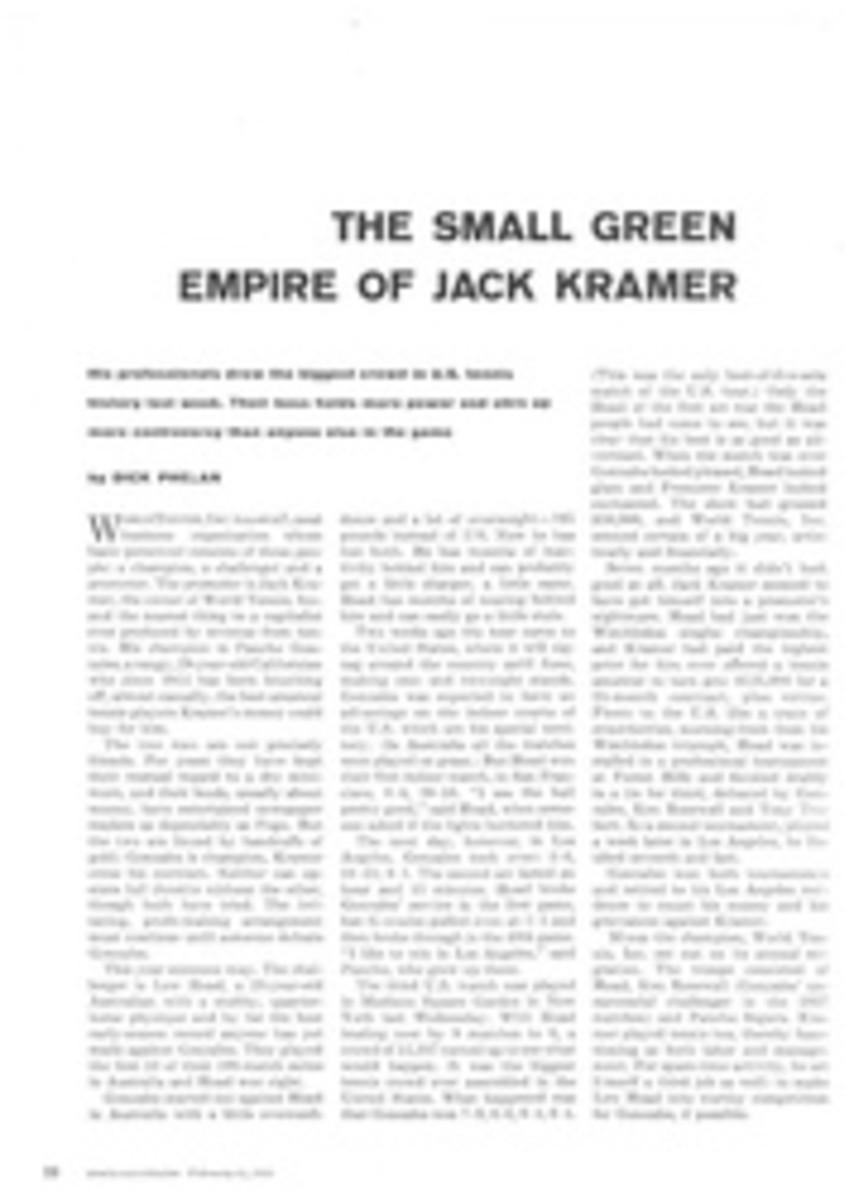
Massa on Cold, Cold Ground
When the glamour boys of the ski world—the jumpers and the downhill skiers—gather at Iron Mountain, Mich, or Aspen, Colo, you can expect spectators to turn out in the thousands. Not so for the tassel-topped cross-country skier who is lucky to have 150 on hand to see him push off on a punishing 15-kilometer race, and luckier still if half that many stick around for the finish. Cross-country skiing is just not the ideal spectator sport. The typical run is an uphill-downhill slog over rough, bone-chilling terrain, with no grandstand facilities whatsoever, and the cross-country men like it that way.
So do the small but hardy breed of true cross-country fans. Some 200 of them gathered at Rumford, Maine the other day and shivered through a snowstorm to catch glimpses of the U.S. championships run over a 15-kilometer course.
The highlight of the show was the performance of Florida-born Leo Massa, 28, currently a carpenter in Red Bank, N.J., who spent five of his pre-teen years learning cross-country skiing in his father's native Finland. Nothing Massa did at Rumford could match the spectacle of a jumper flying 250 feet through the air or of a downhill man cartwheeling through a spray of snow after a bad spill, but let nobody imagine that his run was any the less testing.
Snow was falling hard, but preceding runners had marked a clear track for Massa. He set off rhythmically through the cold, piny stillness, a stillness broken only by the effort of his breathing and the scraping noise his skis made on the snow. Some 40 minutes out he reached the old trapper's line shack marking the halfway point. The shack also marked the beginning of the long climb which zigzagged up the mountain for two and a half miles. This stretch of the race would be a long, tiring pull, yet somehow he would have to save energy for the finish.
Massa had started last in a field of 22. The skiers, or runners as they like to call themselves, had been sent off at one-minute intervals from the school-house down in the village of Rumford. By the line shack, Massa had overtaken four runners and was moving easily, effortlessly in the long, gliding stride that marks a good cross-country man.
That morning, when he drew the last starting position, Massa had been pleased. A misty rain which had been falling since dawn had formed an icy crust on the trail, and he knew that the first runners would have rougher going. Fifteen minutes before Massa's own starting time the temperature dropped 2° to just below freezing, and the rain turned to snow. Most of the skiers, including Massa's five teammates on the American Federation Internationale de Ski team (FIS) had waxed their skis with a soft klister wax—good for an ice track. The fresh snow presented an entirely different waxing problem.
Massa hurried to the boiler room of the schoolhouse and dug into a canvas sack. He pulled out a can of red klister wax (soft) and a can of green klister (hard). "What do you think?" he asked Sven Wiik, coach of the FIS squad.
"I think we'd better mix the red and green," said Wiik. "If you use too soft a wax, this new snow is going to stick to the bottom of your skis."
While Massa burned the old wax off his skis with a blowtorch, Wiik mixed the red and green klister. The two worked quickly to apply the new mixture to the bottoms of Massa's slender Finnish cross-country runners; then Massa went out into the snow for his start.
"It's the best we can do," said Wiik. "I hope it works."
Far out on the track, just as Massa was starting, Tauno Pulkinen, another member of the U.S. Nordic team, pulled off the track and stopped. For the past two miles he had been pounding along the trail with two inches of ice stuck to the bottom of his skis. He had used a soft wax and had had no time to change when the snow started. The ice sticking to his skis practically eliminated any glide. He saw it was useless to continue, so he kicked out of his bindings and sadly started the long trudge back to the schoolhouse. It was the first time the big Finn had ever had to quit in a race. He had won the national championship six times before.
When Massa was but a mile out on the course, he felt extremely tired. "I didn't have enough time to get warmed up properly before my start," he explained later, "and that first uphill climb drained me." Then he saw Pulkinen trudging back along the trail. "Pulkinen's out," he thought with excitement. He dug in his poles with new determination and got his second wind.
With each stride he leaned, arm extended, far out over the ski on which he was gliding. The balletlike motion centered the weight of his frame on one ski and enabled him to get a maximum amount of distance out of each glide—much as a championship crew would strive to get the maximum run out of its shell with each stroke.
The day before the race Massa and his five teammates went through a light morning workout and then spent the afternoon lounging lazily in the living room of the white frame house which was their headquarters in Rum-ford. The talk was mostly of training methods.
"We chase elk out in Colorado," said Sven Wiik, the coach. "We chased one last winter for about 30 miles until it fell exhausted up in the deep snow." He said it simply, yet there was an unmistakable pride in his tone which seemed to say that a man of the 20th century could beat a magnificent animal in a contest of endurance.
Sven Johanssen, a team member from Anchorage, Alaska, nodded as he listened to Wiik. "Yes," he said. "I know. I do the same in Alaska, only I chase moose. It's a thrill to see them fall, completely spent, and you know you could have kept going for another 10 miles."
Johanssen ran his fingers through his blond hair. "The Army should teach cross-country," he said. "There was a plane crash up in the mountains outside Anchorage last year. It took the Army rescue team two days to get to the crash with Sno-Cats and weasels. I made it skiing crosscountry in four hours."
The group all nodded in agreement with Johanssen and then shook their heads at the illogical Army.
Massa, who had been quiet until then, said: "I don't get on snow until November. I can't chase elk in Red Bank, New Jersey. I bought a pair of roller skis. They're regular skis with three wheels on the bottom. I ski along the road in the late summer and fall, poles and all. People in cars see me and they almost go off the road. I just keep my head down and roll along."
"Yeah," said Pulkinen, "I know what you mean. I roller-ski in Prospect Park in Brooklyn. It's worse."
Mack Miller, who placed first among the U.S. cross-country skiers in the 1956 Olympics, laughed. "I'm glad I don't live in Brooklyn." Miller grew up in spacious Colorado. "I love the mountains," he said. "I think that's what I like best about cross-country skiing. You get out there on a trail by yourself and it's kind of peaceful, yet there's a feeling of adventure that never escapes you. You never know what you're going to find along the track."
Sven Wiik said, "I know what you mean. Sometimes, even in the middle of a race, I've come upon places so beautiful that I felt I must stop to capture the moment. It is this feeling, I think, that makes a cross-country skier."
By the time Massa got to the top of the long hill he had passed two more runners. He knew now that he must be making good time and could not be too far off Mack Miller's clocking. Miller led the field at the halfway mark.
He started down the incline—it was all downhill now except for a little incline near the finish line—when he thought of the dogs.
There were two big dogs at a farmhouse about half a mile farther, where the trail paralleled a country road. Two days ago the dogs had jumped Tauno Pulkinen and the big Finn had not only lost precious seconds in his practice run, but also came close to having his snow pants chewed clear through. As Massa neared the road, his ears strained for sounds of barking. The farmhouse loomed up; still no dogs. Then he was past, and all he had to worry about was his endurance.
A mile from home Massa saw Pulkinen, who had skied out from the finish line to shout encouragement to his teammates. "You're five seconds behind Miller," Massa heard him shout, and then he was past the big Finn and heading in on the homestretch.
The last 400 yards of the race coursed down a snow-covered street at the edge of Rumford. Shouting spectators lined both sides as Massa shot home.
He was timed in one hour 16 minutes 50 seconds. He beat Miller by 58 seconds.
"When Pulkinen told me I was only five seconds behind, with a mile to go," he explained over hot tea, "I knew I had to pour it on. I did."
Coach Wiik was pleased with the results, no doubt looking ahead to the world championships in Lahti, Finland, March 1-9. "Maybe we don't win over there against the Russians, the Finns, the Norwegians and the rest," he said, "but we'll do better than ever before."
PHOTO
LEO MASSA poured on the steam during the last mile to nip Miller by 58 seconds.
PHOTO
MACK MILLER came flying out of the pines at the halfway mark leading the field by almost a minute, but he could not match Massa's burst of speed in the homestretch.

